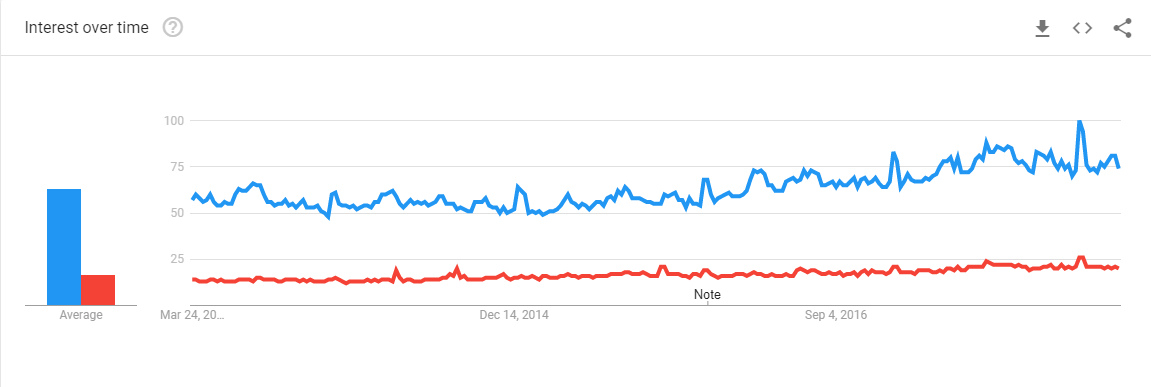It’s easy to get caught up focusing on your own digital presence and forget about the rest of the digital world, aka your competition. While there is much to learn from your own digital performance data over time, looking at your competitor’s digital strategy can open your eyes to:
- What is working for others in your industry
- What is not working for others in your industry
- Where you stand compared to your competition
- Opportunities for testing
No two companies or industries are the same, so every competitive analysis will be a bit different. In this post, we’ll walk through 4 areas we focus on when performing a competitive analysis and key items to look at in each area.
1. Brand Awareness
Relative Branded Search Volume (Google Trends)
When conducting a competitive analysis, begin by comparing the brand awareness between two companies.
Since “brand awareness” is a bit ambiguous, a good way to measure it is through Google Trends. Google Trends is a public web facility of Google Inc., based on Google Search, that shows how often a particular search term is entered relative to the total search volume across various regions of the world, and in various languages.
Example: Google Trends can help explain how a brand compares to the competitor. Below, we compare McDonald’s brand awareness (blue) to Burger King’s (red) over the past five years.

2. Organic Search
Top Traffic-Driving Keywords & Overlapping Keywords
Organic search should be a primary component of your competitive analysis. Begin by analyzing the top performing organic keywords and overlapping keywords. This information allows you to see what keywords are working well for a competitor, and where your brand needs to improve. “Top keywords” are defined as keywords on the first two pages of Google. Top keywords show which content is driving a lot of organic traffic for a competitor.
Example Finding: In one case, we found that a competitor was ranking for keywords in question form. This competitor was producing articles and guides to help visitors learn more about the product and were ranking for these question queries. This was a great opportunity for our client to start creating educational content to rank for similar keywords and help answer consumers’ questions about their products.
Overlapping keywords show which keywords your brand and a competitor are both excelling in, and what keywords need improvement.
Overall, understanding your competitor’s organic presence can help you know where you need to improve your website and where you are beating the competition. Organic search tends to be the number one source driving traffic to your site, so ensuring that you are competing with others in your industry is important. (Regardless of how crowded Google search engine results pages are becoming, organic listings still get more clicks than the paid listings, so it pays to make sure you’re showing up for the right searches.)
3. Inbound Links
Domain Authority & External Equity-Passing Links
When analyzing inbound links, we use a metric called domain authority that predicts how well a website will rank on a search engine. If the competitor has a higher domain authority, a search engine may deem that website’s content as more reliable and show it higher in the search results. Domain authority is influenced by root domains, number of total links, and more.
To further analyze a competitor, take a look at their external equity-passing links. These are links from other websites that link to you or your competitor’s website and provide value to search engines. When analyzing the websites linking to your competitor’s website, you can determine if they are also relevant to your brand or not.
4. Paid Search
Top Performing Paid Keywords, Overlapping Keywords, Ad Messaging, Display Targeting, and Landing Pages
Paid search is our final focus and one of the largest portions of a quality competitive analysis. In this section, we focus on a competitor’s top performing paid keywords, overlapping keywords, paid display targeting, and landing pages. There is much to be learned about a competitor’s digital strategy in this part of the analysis.
Top performing keywords shed light on what terms are driving traffic to your competitor’s website. Sometimes businesses will have campaigns for products outside of the comparing business units. After successfully filtering down the keywords that are relative to your brand, you can see which keywords are most important to their paid search efforts. Are these keywords driving conversions? Are these keywords worth spending money on? Do you share some of their top paid keywords?
Example Finding: In one case, we noticed that a competitor was spending a lot of money on AdWords. Looking more closely at their keywords, we noticed that many of their keywords were expensive and followed a “thought leadership” theme. In other words, these keywords were not relevant to consumers looking to purchase their product. We concluded that the competitor did not care how much money they were spending and were not focused on driving conversions. While some of their keywords were similar to ours, we did not want to follow their AdWords strategy.
Overlapping keywords show the exact keywords you and a competitor are competing over. When looking at the overlapping keywords, you can see what campaigns and products are overlapping each other. This is where you will find if any competitors are bidding on your company’s branded terms.
Ad copy is another key area to analyze. Ad copy can show what a competitor is using to gain users attention. By knowing the unique value propositions a competitor utilizes, your brand is better equipped to compete with them. For instance, if the competitor is offering “24/7 support,” “award-winning customer service,” or “quick and easy setup,” you can ensure that your brand offering is competitive and your ad copy shows that.
Another aspect of paid search to take note of during a competitive analysis are the landing pages used. Connecting the ad campaign and ad groups to their landing pages provides you with the full picture of the competitor’s paid search experience. This information allows you to see if the competitor is testing different landing pages, what type of information they are offering (product info, a webinar, a contact form?), or if they are even sending traffic to a relevant page. We often see brands sending traffic to their homepage or an irrelevant page instead of a designated landing page. Noting these differences and how you can create a better experience for users on your landing pages is very useful.
If you’re going to succeed, you have to know what you’re up against. So to recap: next time you’re analyzing your competitors, here are the four things we recommend focusing on to get you started:
- Brand Awareness – What do trends say about how popular your competitor’s brand is compared to yours?
- Organic Search – What search terms do your competitors rank highly for? Where are they beating you?
- Inbound Links – What do the links driving traffic to your competitor’s site say about the authority and reliability of your competitor?
- Paid Search – What keywords do your competitors consider important enough to spend money on? What kind of ad experience are they offering?
Armed with this information, the next step isn’t always easy, but it sure is simple: do it better than the competition. Good luck!
Want to see how you stack up against your competition? Talk to us about a competitive audit.
